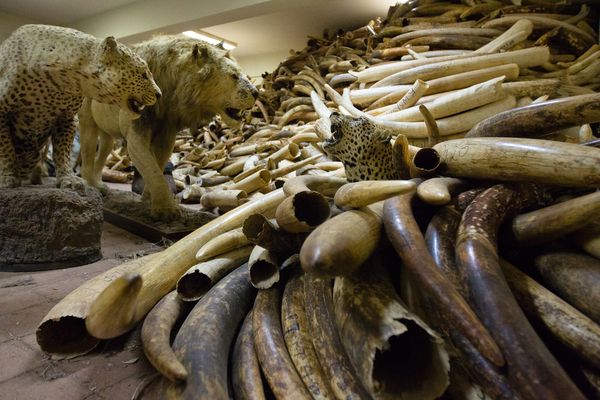Cold War Radioactivity Can Date Illegal Elephant Ivory
A strong room underneath the Kenya Wildlife Service headquarters holds confiscated ivory.
Fallout from long-ago Cold War explosions is now a forensic tool in the very modern war against elephant poachers and the illegal trade in ivory.
It's a war that's never been hotter. Despite a 1989 international ban on ivory sales, elephant poaching is a bigger business than ever, with an estimated 30,000 African elephants being killed for their tusks last year alone—a rate of slaughter, say wildlife experts, that could drive the majestic animals to extinction within the century.
Much of the ivory is destined for China and the Far East, where it can fetch upward of $1,300 a pound.
Law-enforcement officials trying to stem the tide have had to contend not only with highly organized criminal gangs, but also with complexities in international law that allow ivory acquired before the 1989 ban to be legally bought and sold.
Trying to distinguish legal (pre-1989) ivory from poached (post-1989) ivory has been nearly impossible—until now.
A new ivory-dating technique, described this week in the journal Proceedings of the National Academy of Sciences, relies on radioactive isotopes released into the atmosphere during atom bomb tests in the 1950s and '60s. A ban on aboveground nuclear testing went into effect in October 1963.
Known as bomb-curve dating, the technique allows scientists to detect radioactive isotopes within ivory or tusks and thus determine to within a year the time the elephant died or was killed. The bomb curve is the fluctuating concentration of carbon-14—a heavily radioactive isotope—in the atmosphere since the 1950s.
"This will tell us the age of the piece and thus whether or not it was acquired legally," said study leader Kevin Uno, a postdoctoral researcher at Columbia University's Lamont-Doherty Earth Observatory.
"It is a simple, accurate, and affordable test and will make it far easier to enforce the ivory ban."
How does bomb-curve dating work?
The level of carbon-14 in the atmosphere nearly doubled during the years of aboveground nuclear testing, from 1952 to 1963. Scientists have been charting these elevated readings since the mid-1950s.
This newly made carbon-14 swiftly oxidized into carbon dioxide in the atmosphere, and in turn was absorbed by plants. When herbivores such as elephants digest the plants, the carbon-14 values in the plant tissue become locked into their hair, horn, teeth, and tusks.
By comparing the levels of carbon-14 in ivory samples with the levels of the isotope known to be in the atmosphere at various points along the bomb curve, the researchers can figure out the date of the sample.
What did the scientists do in the study?
For one thing, obtaining chunks of ivory in the tightly regulated legal market was not easy. The Salt Lake City Zoo allowed the team to take samples from their elephant Misha, who died in 2008, while Kenyan authorities gave the researchers permission to take domino-size samples from tusks of an elephant named Amina, which died at the Samburu National Reserve in 2006.
Using an accelerator mass spectrometer, the researchers then measured the radiocarbon levels at the base of each tusk and used these figures, plotted on the bomb curve, to calculate independently when the animal died—comparing the results with the elephants' known dates of death. The team also tested these results against those obtained with similar tests on monkey hair, hippo teeth, oryx horn, and elephant tail hair.
How accurate is it?
It depends, Uno said. "In the best case, which is for ivory that formed between about 1955 and 1995, we can determine the age with the precision of about one year.
"Tusks form throughout the life of the elephant, and the most recently formed tissue is at the base of the tusk. So if we sample and date the base of the tusk, we can estimate year of death."
Are there similar techniques out there?
The new bomb-curve dating technique also complements an ivory DNA test developed by researchers at the University of Washington, which allows investigators to determine the geographic origin of a piece of suspect ivory.
"The DNA test tells us where the ivory came from, [and] bomb-curve dating tells us when. With the where and the when in hand, we can focus anti-poaching efforts on the hot spots."
Added Uno, "This is truly a case of scientists using lemons to make lemonade. It's a huge gift to science."
Roff Smith
for National Geographic
Published July 1, 2013












